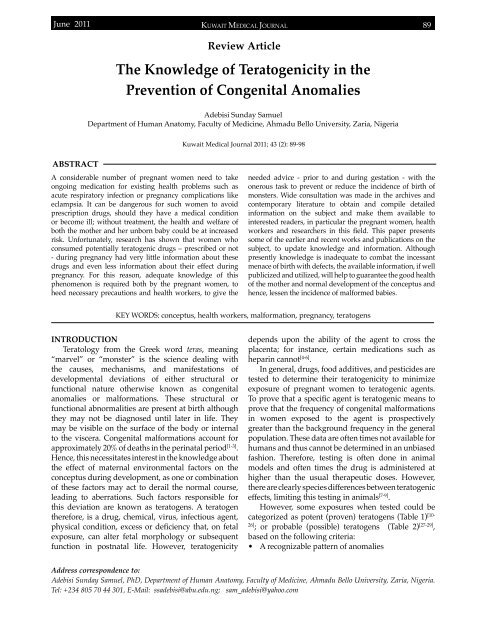Vol 43 # 2 June 2011 - Kma.org.kw
Vol 43 # 2 June 2011 - Kma.org.kw
Vol 43 # 2 June 2011 - Kma.org.kw
You also want an ePaper? Increase the reach of your titles
YUMPU automatically turns print PDFs into web optimized ePapers that Google loves.
<strong>June</strong> <strong>2011</strong><br />
KUWAIT MEDICAL JOURNAL 89<br />
Review Article<br />
The Knowledge of Teratogenicity in the<br />
Prevention of Congenital Anomalies<br />
Adebisi Sunday Samuel<br />
Department of Human Anatomy, Faculty of Medicine, Ahmadu Bello University, Zaria, Nigeria<br />
Kuwait Medical Journal <strong>2011</strong>; <strong>43</strong> (2): 89-98<br />
ABSTRACT<br />
A considerable number of pregnant women need to take<br />
ongoing medication for existing health problems such as<br />
acute respiratory infection or pregnancy complications like<br />
eclampsia. It can be dangerous for such women to avoid<br />
prescription drugs, should they have a medical condition<br />
or become ill; without treatment, the health and welfare of<br />
both the mother and her unborn baby could be at increased<br />
risk. Unfortunately, research has shown that women who<br />
consumed potentially teratogenic drugs – prescribed or not<br />
- during pregnancy had very little information about these<br />
drugs and even less information about their effect during<br />
pregnancy. For this reason, adequate knowledge of this<br />
phenomenon is required both by the pregnant women, to<br />
heed necessary precautions and health workers, to give the<br />
needed advice - prior to and during gestation - with the<br />
onerous task to prevent or reduce the incidence of birth of<br />
monsters. Wide consultation was made in the archives and<br />
contemporary literature to obtain and compile detailed<br />
information on the subject and make them available to<br />
interested readers, in particular the pregnant women, health<br />
workers and researchers in this field. This paper presents<br />
some of the earlier and recent works and publications on the<br />
subject, to update knowledge and information. Although<br />
presently knowledge is inadequate to combat the incessant<br />
menace of birth with defects, the available information, if well<br />
publicized and utilized, will help to guarantee the good health<br />
of the mother and normal development of the conceptus and<br />
hence, lessen the incidence of malformed babies.<br />
KEY WORDS: conceptus, health workers, malformation, pregnancy, teratogens<br />
INTRODUCTION<br />
Teratology from the Greek word teras, meaning<br />
“marvel” or “monster” is the science dealing with<br />
the causes, mechanisms, and manifestations of<br />
developmental deviations of either structural or<br />
functional nature otherwise known as congenital<br />
anomalies or malformations. These structural or<br />
functional abnormalities are present at birth although<br />
they may not be diagnosed until later in life. They<br />
may be visible on the surface of the body or internal<br />
to the viscera. Congenital malformations account for<br />
approximately 20% of deaths in the perinatal period [1-3] .<br />
Hence, this necessitates interest in the knowledge about<br />
the effect of maternal environmental factors on the<br />
conceptus during development, as one or combination<br />
of these factors may act to derail the normal course,<br />
leading to aberrations. Such factors responsible for<br />
this deviation are known as teratogens. A teratogen<br />
therefore, is a drug, chemical, virus, infectious agent,<br />
physical condition, excess or deficiency that, on fetal<br />
exposure, can alter fetal morphology or subsequent<br />
function in postnatal life. However, teratogenicity<br />
depends upon the ability of the agent to cross the<br />
placenta; for instance, certain medications such as<br />
heparin cannot [4-6] .<br />
In general, drugs, food additives, and pesticides are<br />
tested to determine their teratogenicity to minimize<br />
exposure of pregnant women to teratogenic agents.<br />
To prove that a specific agent is teratogenic means to<br />
prove that the frequency of congenital malformations<br />
in women exposed to the agent is prospectively<br />
greater than the background frequency in the general<br />
population. These data are often times not available for<br />
humans and thus cannot be determined in an unbiased<br />
fashion. Therefore, testing is often done in animal<br />
models and often times the drug is administered at<br />
higher than the usual therapeutic doses. However,<br />
there are clearly species differences between teratogenic<br />
effects, limiting this testing in animals [7-9] .<br />
However, some exposures when tested could be<br />
categorized as potent (proven) teratogens (Table 1) [10-<br />
26]<br />
; or probable (possible) teratogens (Table 2) [27-29] ,<br />
based on the following criteria:<br />
• A recognizable pattern of anomalies<br />
Address correspondence to:<br />
Adebisi Sunday Samuel, PhD, Department of Human Anatomy, Faculty of Medicine, Ahmadu Bello University, Zaria, Nigeria.<br />
Tel: +234 805 70 44 301, E-Mail: ssadebisi@abu.edu.ng; sam_adebisi@yahoo.com
















